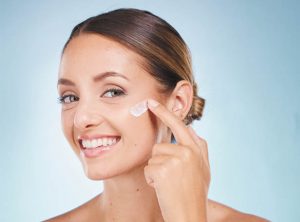By Bo Martinsen, MD
 Dry eye complaints are on the rise worldwide – but there’s a poor correlation between dry eye sufferers’ subjective experience and what medical tests detect. What can explain the disconnect?
Dry eye complaints are on the rise worldwide – but there’s a poor correlation between dry eye sufferers’ subjective experience and what medical tests detect. What can explain the disconnect?
Many factors – including age, gender, air pollution, computer use, and contact lenses – play a role in dry eye problems. But few are aware of another driver: The exploding use of cosmetics and anti-aging face creams.
The TRP System: A Revolutionary Discovery for Dry Eye Management
Scientists have long recognized that regular use of cosmetics and preservative-laden skin products influence eye health. Commonly, it’s thought that eye irritation might be due to cosmetic and face cream ingredients migrating onto the ocular surface.
But there is also another mechanism at work.
In 2021, the Nobel Prize in Physiology or Medicine was awarded for the discovery of special TRP ion channels. The TRP system helps explain why the products we put on our face impact our eye health.
In short, beauty products activate special TRP ion channel receptors that trigger pain and inflammation.
How the TRP System Works
On the ocular surface and the skin around our eyes, we have lots of TRP ion channels. These channel receptors sense environmental factors, like temperature, pressure, pH levels and chemicals in our surroundings. They then send this information to the brain to compose a response, like blinking or tearing, via the trigeminal nerve.
The ocular surface and eye tissue are densely “innervated” with TRP systems, which is why these areas are so sensitive to the environment.
Unfortunately, the TRP system can get disrupted. Dry eye sufferers typically exhibit TRP imbalances in their ocular tissue. This makes the eye less able to adjust to environmental changes.
There are at least 28 different types of TRP channels, and many of them are involved in dry eye symptoms.
How Anti-Aging Creams Become Dry Eye Producers
Vitamin A derivatives, or retinoids, are among the most common ingredients found in anti-aging creams. They’re typically thought to reduce wrinkles and improve skin appearance after initial irritation.
Unbeknownst to many, retinoids can contribute to Meibomian gland dysfunction and eye discomfort – even when applied far away from the eye. This could be because retinoids stimulate at least one type of TRP (TRPV1), which initiates inflammation.
If the skin around the eye experiences chronic, low-grade inflammation, havoc can develop over time. It can cause discomfort and a poor tearing response – common symptoms of dry eyes.
Other common skin cream ingredients – like the preservative phenoxyethanol – also stimulates TRPV1. As do external factors like UV radiation and air pollution. These factors are already known drivers of dry eyes, and the TRPV1 connection can help explain why.
Chronic stimulation of TRPV1 and the resulting inflammation may have consequences for not just the eyes, but the skin too. Some experts worry that while retinoids can smooth wrinkles in the short-term, high doses and prolonged use may actually accelerate skin aging over time.
Interestingly, a variety of skin problems, like rosacea and photodamaged skin, are also characterized by over-stimulated TRPV1 and strongly correlated with dry eye problems. That’s a good reason to address both skin and eye issues at the same time.
Read the Ingredients
If you struggle with dry eyes, take a close look at your skincare products. Do they contain retinoids or harsh preservatives, like phenoxyethanol? If so, it might be time to look for something new.
The good news is that certain ingredients are TRPV1 inhibitors, meaning they can help reduce inflammation. TRPV1 inhibitors include omega-3s, melatonin, as well as many antioxidants and plant extracts. In the right ratios and doses, these ingredients can provide a calming effect and support eye and skin moisture.
These kinds of ingredients are now starting to make their way into eye care-oriented skin products, like Barristrong®. However, it’s important to note that since the TRP system is complex, all of the ingredients have to work in synergy to successfully reduce inflammation and support eye comfort.
For references and to learn more, visit omega3innovations.com.
Bo Martinsen, MD
Dr. Martinsen is an omega-3 specialist, innovator, and advocate for natural foods. As co-founder and CEO of Omega3 Innovations, he has created several medical food products that combine effective doses of omega-3s with fibers and other nutrients. Before Omega3 Innovations, Dr. Martinsen practiced medicine in Norway for over 20 years.
941-485-4400
omega3innovations.com








